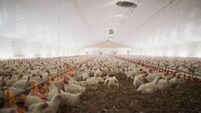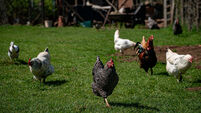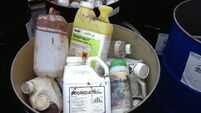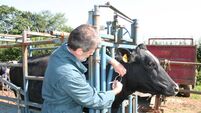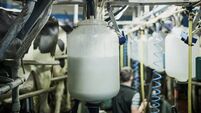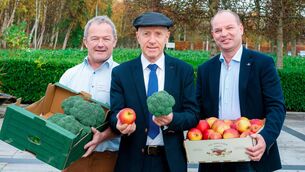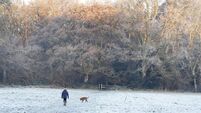Why Ireland has escaped the impact of bird flu — for now
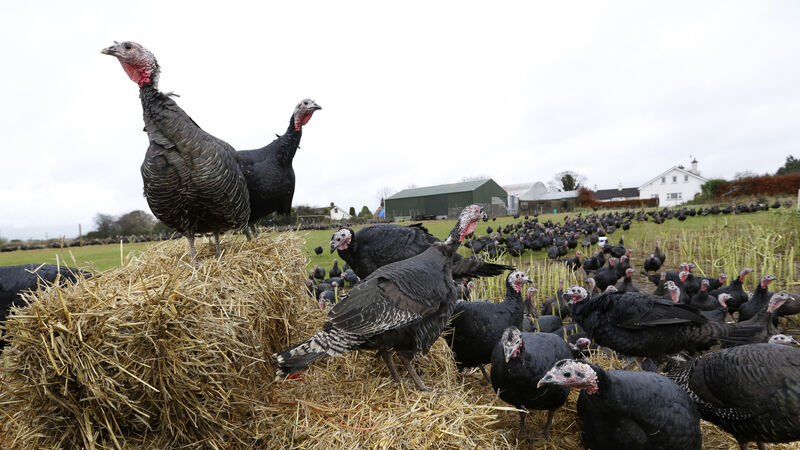
Despite initial fears around supply as consumers looked to other countries struggling to contain the disease, families across Ireland were able to enjoy an Irish turkey this Christmas. File Picture: RollingNews.ie
Poultry housing orders are likely to be routine into the future as the quest for a vaccine to protect birds against avian influenza continues across Europe.
In recent weeks, Minister for Agriculture Charlie McConalogue announced the removal of the remaining highly pathogenic avian influenza (HPAI H5N1) surveillance zone, which was located in Co Monaghan with a small area of Northern Ireland also included.
While the removal of the movement restrictions on poultry within the zone is a welcome event, the Department of Agriculture emphasises that the country is still in the high-risk period for bird flu and will remain so until at least the end of April.
Senior superintending veterinary inspector at the Department of Agriculture Paul Corkery said that with this recent announcement, there might be a feeling out there “that we’re out of the woods”.
“The housing order is still in place, and that’s really, really important that people don’t forget that birds need to continue to be housed during this high-risk period,” Mr Corkery explained.
“We certainly are not of the view that the risk is gone away; it’s still there, and we want people to remain vigilant and keep working with us.
In November 2022, outbreaks of bird flu were confirmed in two poultry flocks in Co Monaghan, which led to around 8,000 birds being culled.
Despite initial fears around supply as consumers looked to other countries struggling to contain the disease, families across Ireland were able to enjoy an Irish turkey this Christmas.
The current state of play, Mr Corkery told the , is that there are no cases of bird flu in poultry right now in Ireland.
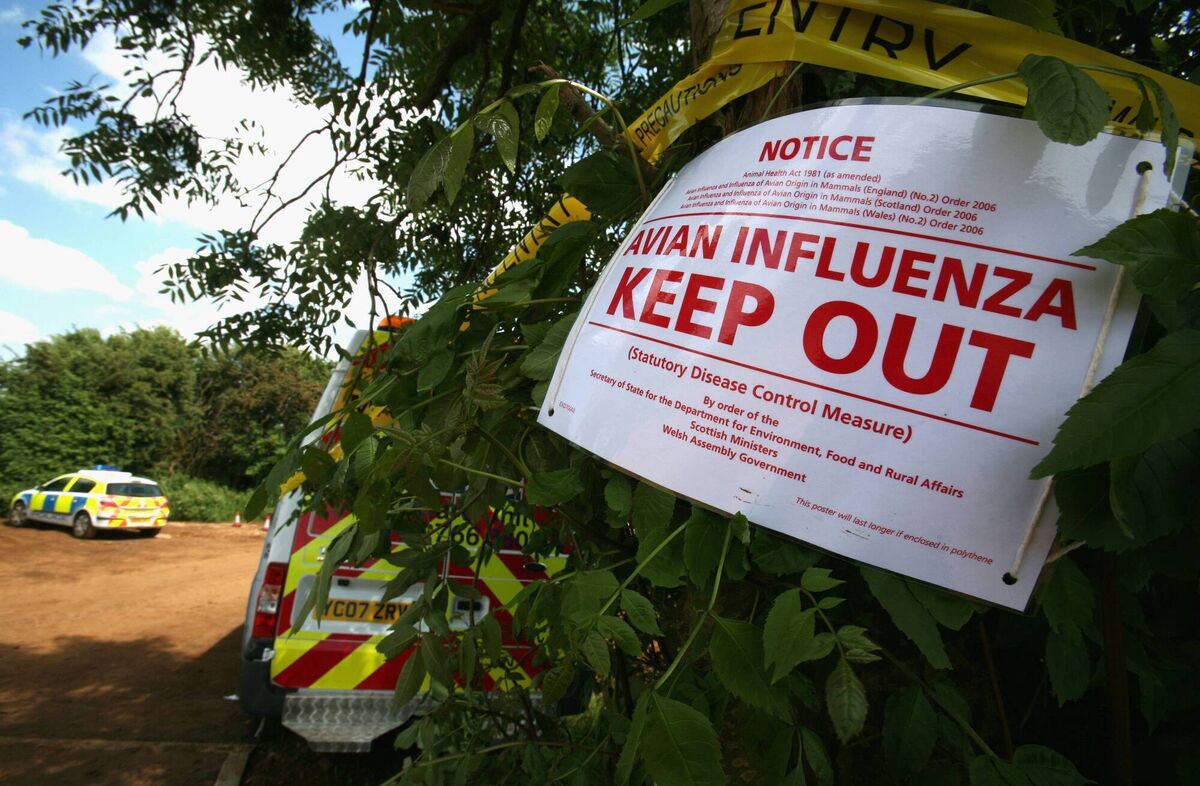
“There's a distinction between the cases in wild birds and we would have cases in wild birds practically every week,” he said.
The department has sufficient evidence of HPAI H5N1 in wild birds in coastal counties and, because of this, it has stopped collecting birds for surveillance purposes from coastal counties.
“Currently we're not testing wild birds from coastal counties because we had so many positives in the coastal counties that we didn't want to use up our lab capability testing checking what we already know: that there's lots of it in the coastal counties with the seabirds,” Mr Corkery said.
The UK and France, two countries experiencing a “terrible time” with bird flu at the moment, have significant cases of it in coastal regions as well, Mr Corkery said.
“That's because the seabirds are particularly susceptible to it, and seabirds tend to live in colonies, move on mass together,” he explained.
“Whereas if you think of your garden birds, a lot of the time robins and birds like that, they're fairly solitary so they're not in big groups so the disease doesn't spread as readily.
“And some of those species then don’t seem to be as susceptible either to the disease.
Turkeys are very susceptible to it, Mr Corkery said, and when they get it, “they tend to die fast”.
“Whereas ducks and geese tend to get it but show less signs of the disease. So it just depends on the species really,” he added.
Ireland’s cases in commercial flocks in 2022 appear to pale in comparison with the millions of birds that had to be culled in countries across Europe, and the US, for example.
How did Ireland, thus far this season, avoid the extremity of the situation seen in other countries?
“There are huge numbers of cases depending upon where the highest number of wild bird cases are,” Mr Corkery said.
“If you look at the epidemiology of the disease you'll find it's universally accepted in all countries that when you have a case, a wild bird incursion is what's generally the cause of the infection.

“In some way, the biosecurity has broken down in the poultry unit and the wild birds have managed to contaminate the poultry.
“Ducks being ducks like water, and so on. They like to be outdoors.”
In Ireland, we are “able to have a housing order where we instruct farmers to bring their birds in”, but in countries with more intensive outdoor poultry, a housing order may not be as much of an effective measure.
Mr Corkery said Ireland is fortunate in that while we have free-range systems, in the majority of cases, “when we bring in a housing order, a law essentially that says that anyone who keeps poultry must keep them indoors, most people are able to comply with that”.
“We don't have this really intensive outdoor system,” he explained.
“We have ranges, but they tend to have housing as well, I suppose it’s partly to do with our climate, that you won't be able to raise poultry here unless you have proper housing.”
Mr Corkery said that the industry itself in Ireland “is leading the way really in how to do biosecurity”.
The Department of Agriculture has stressed that biosecurity is the best defence against the spread of disease, including avian influenza, to a poultry flock.
“The key thing is to make sure that people aren't coming onto your poultry holding without your knowledge, and the second thing is that the minimum number of people that have to come onto the premises come onto the premises and there are protocols in place,” Mr Corkery said.
Personnel and visitors should wear disposable or dedicated outer clothing when in contact with birds, along with wearing boots that can be disinfected, disposable gloves and wash hands after contact with poultry, and only allowing essential personnel access to birds.
However, biosecurity is not only just about the footwear and the personnel going into the house, Mr Corkery explained.
“It's also to do with the actual construct of your house. So you want to make sure that wild birds can't actually get in, so that you don't have seagulls or even pigeons or worse again, if you had waterfowl able to get into your house,” he said.
Biosecurity is not the only aspect in keeping bird flu out of Ireland’s commercial flocks, however.
“When it comes to our nearest neighbours, the UK, they've had a lot of cases," Mr Corkery continued.
“Through their surveillance of the wild birds, they had positives before we had and it really depends on what flight pathways your wild birds are moving on.
“If it gets very, very cold early on, they can go further north.
“We’re not perhaps equally comparable to the UK; they're certainly showing evidence that they had more infected wild birds than we've had.”
Ireland appeared to have fared better in 2022 than in 2021 with the number of cases of bird flu in commercial flocks.
“It might look like we did a lot better this year, we certainly need to do better with two cases,” Mr Corkery said.
“The difference statistically between having two cases and having six isn't that much different when you look at the overall number of poultry producers.
Mr Corkery said it is likely that housing orders will be routine for years to come in Ireland.
“Countries that have been so badly affected such as France are on a real quest to find a vaccine,” he said.
“It's no longer seen as a seasonal issue in France, it's now seen as a year-round issue.
“The French are really pushing hard and they have the support of the European Commission and other member states as well.
“The Dutch would be one of the biggest producers in Europe, and then the French would be next in terms of poultry production.
“The Dutch are running a number of trials and the French are as well.”
Mr Corkery said it is hoped that early in 2023 that the results of these trials will be known.
“The French believe that the only way out of this is to use a vaccine in some way, and we support that within Europe – we’re all at risk,” he said.
“We can see that as time goes on, each year, we’re seeing more and more [cases] especially in the northern hemisphere, Canada had a lot of cases, USA has had a lot of cases, and it looks like it’s going to continue to get worse.”
Another factor, Mr Corkery said, is that there is a push for more free range poultry.
“That’s the direction we want to move in and it’s unlikely that’s going to stop, but that has brought this other risk that outdoor birds are far less biosecure because of their relationship with the wild birds,” he said.
“There are vaccines that are used in the poultry sector for other diseases and they work successfully, so it’s certainly within the bounds of what’s possible scientifically to do.”
If a vaccine does work, “we certainly will support it and it would be great if it happens”, Mr Corkery said.
Irish Farmers' Association poultry chair Nigel Sweetnam said that it has been a very stressful time for poultry farmers with the risk of bird flu.
This was compounded by the exorbitant costs of raising birds in the past year, with increases seen in prices of inputs such as feed and energy.
“The situation in the UK really heightened the Irish awareness of the threat of bird flu,” Mr Sweetnam told the .
As a result of bird flu, the UK lost around half of its supply of free-range Christmas turkeys either to them dying or being culled. There have also been egg shortages experienced there.
Mr Sweetnam said that Irish farmers were very proactive, which played a significant part in them keeping bird flu out of their flocks.
“Going forward, we’ve called for TAMS to have poultry netting included as a measure,” he added.
Bloomberg reported late in 2022 that since October, poultry losses “are almost 70% above last year’s pace, hitting 16.1m by December 1, according to the World Organisation for Animal Health [WOAH]”.
“Before then, more than 138m birds were lost in the 12 months through September, more than the prior five years combined, WOAH said.”
The ongoing HPAI epidemic is the largest ever observed in Europe.
In the first year of the epidemic, which ran from October 2021 to September 2022, a total of 2,520 outbreaks in poultry, 227 in captive birds, and 3,867 detections in wild birds were notified in 37 European countries.
The unusual persistence of HPAI in wild birds and poultry throughout the summer of 2022 means that for the first time there was no clear separation between the end of the first year of the epidemic and the beginning of the 2022 HPAI season, which began in October.
